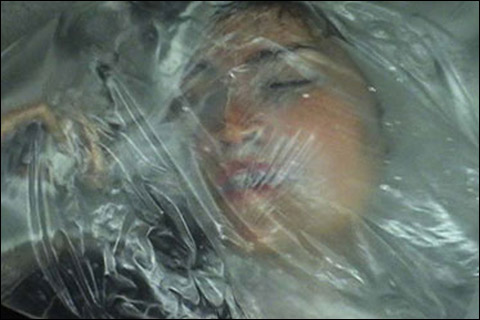Tavares Strachan's rockets, plus 'The Boat Show' at Drive By, and 'Sensed, Unseen' at GASP
By GREG COOK | June 23, 2010

UNDERNEATH: In the video of her performance piece, Faith Johnson rolls a plastic bag filled with water back and forth over her face, smooshing and smothering herself. |
“Tavares Strachan: Orthostatic Tolerance — It Might Not Be Such a Bad Idea if I Never Went Home” | MIT’s List Visual Arts Center, 20 Ames St, Cambridge | Through July 11 “The Boat Show” | Drive By, 81 Spring St, Watertown | Through August 28 “Sensed, Unseen” | GASP, 362 Boylston Street, Brookline | Through July 2 |
In Tavares Strachan's video
The Rocket Launch (2009), two black men in white chemical suits load sugar cane into the back of a three-wheeled mini-truck, then drive down a palm-tree-lined road to a run-down building labeled Bahamas Aerospace and Sea Exploration Center. A police officer on a motorcycle then leads the truck, with a six-foot-tall clear glass rocket mounted on top, to a beach where a man in a chemical suit and a police officer move the rocket onto a launch platform. The camera pulls back to show the rocket standing in the shallows of a lovely beach. After a long wait, smoke billows from the rocket. It curves up into the sky and then slams back down into the shallow water, shattering. Men collect the glass shards from the water, as if picking up the pieces of their crackpot
Right Stuff dreams to return to the drawing board.
The silent, 14-minute, black-and-white video — now on view in the Strachan exhibit "Orthostatic Tolerance: It Might Not Be Such a Bad Idea If I Never Went Home" at MIT's List Visual Arts Center — is a meditation on fragility and futility and aspirations. It is absurd and serious and kind of lovely. But what is Strachan doing daydreaming about a Bahamian space age?
Strachan, who studied at RISD and Yale and now lives in New York, keeps getting drawn back home to his native Bahamas. He attracted attention by creating one of the landmark pieces of global-warming art, The Distance Between What We Have and What We Want, a solar-powered refrigerator preserving a 2.5-ton block of ice carved out of an Alaskan river in 2005. He displayed it at the grade school he attended in Nassau, and then at the 2006 Art Basel fair in Miami. It makes a physical connection between Arctic melting and flooding of islands closer to the equator, as well as to the fossil-fuel consumption that's driving the problem.
 Related
Related:
Slideshow: ''Stan VanDerBeek: The Culture Intercom'' at the MIT List Visual Arts Center, The proto-web utopian consciousness of Stan VanDerBeek, Autumn blossoms: Our 10 most anticipated art shows this fall, More 
- Slideshow: ''Stan VanDerBeek: The Culture Intercom'' at the MIT List Visual Arts Center
Images from ''Stan VanDerBeek: The Culture Intercom'' at the MIT List Visual Arts Center.
- The proto-web utopian consciousness of Stan VanDerBeek
In April 1966, sheriff's deputies were hiding in bushes, peering into a mansion that had been turned into a headquarters and commune for LSD guru Timothy Leary and his pals at Millbrook, New York.
- Autumn blossoms: Our 10 most anticipated art shows this fall
This fall is a season of celebrations and new beginnings as the Museum of Fine Arts opens its new contemporary art wing, the Institute of Contemporary Art turns 75, the Addison Gallery reopens after fixing its roof, and Brandeis's Rose Art Museum reopens after a mini renovation and settling a lawsuit by backing off from its threat to close for good.
- Haacke and Piene at MIT
"Hans Haacke 1967" at MIT's List Visual Arts Center is a science museum presentation with the educational explanation stripped away, leaving just wonder.
- Lost in translation
Spring can't come soon enough, since it'll be bringing with it some engaging museum shows in and around Boston.
- Slideshow: Tavares Strachan's ''Orthostatic Tolerance'' at the MIT List Visual Arts Center
Tavares Strachan's "Orthostatic Tolerance: It Might Not Be Such a Bad Idea if I Never Went Home" at the MIT List Visual Arts Center through July 11, 2010.
- Fall Art Preview: Heavy construction
Over the past decade, museum building has boomed across the region.
- Intimations of life: Camden International Film Festival 2010
Just six years into its life, the Camden International Film Festival — a four-day documentary showcase running from September 30-October 3 at venues in Camden, Rockport, and Rockland — has achieved breakout status on the crowded festival circuit.
- Review: A House in Bali
A House in Bali , Evan Ziporyn's dense syncretic opera, regales you with sounds, moves, images, and contradictions. It's a little like visiting Bali for the first time. The strangeness can be overwhelming, but you'll never forget the clangor.
- Slideshow: Video game heroes run amok in Boston
The Laser Orgy awards ceremony got a little out of control, and we followed our red carpet video game stars as they ran amok in Boston.
- MIT Kinects with the Future
Here in the future, we don't just have park lights that run on dog poop; we're so advanced that cutting-edge technology occasionally shows up in the toy aisle at Wal-Mart.
- Less

 Topics
Topics:
Museum And Gallery
, List Visual Arts Center, Boys & Girls Clubs of America, MIT, More  , List Visual Arts Center, Boys & Girls Clubs of America, MIT, Tavares Strachan, Tavares Strachan, Anne Lilly, Caleb Neelon, GASP, GASP, Derek Aylward, Less
, List Visual Arts Center, Boys & Girls Clubs of America, MIT, Tavares Strachan, Tavares Strachan, Anne Lilly, Caleb Neelon, GASP, GASP, Derek Aylward, Less 